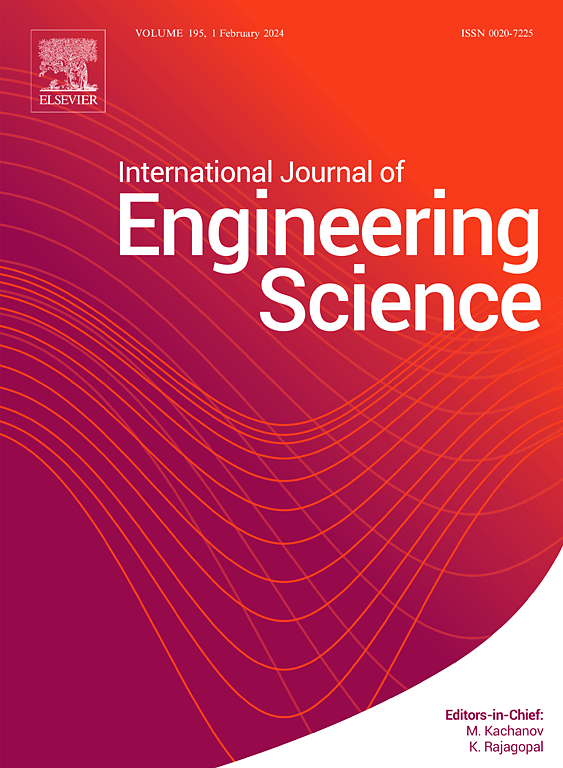二维材料在面内应变和弯曲变形作用下的非线性弹性响应
IF 5.7
1区 工程技术
Q1 ENGINEERING, MULTIDISCIPLINARY
International Journal of Engineering Science
Pub Date : 2025-05-08
DOI:10.1016/j.ijengsci.2025.104270
引用次数: 0
摘要
本文研究了平面内应变和弯曲变形同时作用下二维材料的弹性响应。针对任意对称二维材料的面内变形和弯曲变形,提出了一种非线性弹性本构模型。本构模型由应变和曲率分量对应变能密度的级数展开构成。讨论了面内对称和面外反射对称对线性无关弹性常数数目的影响。在此基础上,提出了一种计算弹性常数的方法。在应变和曲率空间沿射线计算应变能,模拟材料的不同应变和曲率状态。随后,通过将本构模型与试样应变能密度进行曲线拟合,系统地计算了弹性常数。计算弹性常数的方法独立于计算应变能密度的方法,如经典的原子间势或密度泛函理论,因为曲线拟合过程与能量计算解耦。在本工作中,应变能是用经典原子间势来计算的。二维材料的原子坐标在单元格中松弛,同时保留施加的应变和曲率,以便计算应变能,并随后计算弹性常数。我们分析了石墨烯对同时应变和曲率的非线性响应。此外,我们分析了作为代表性正交二维材料的黑磷。计算了两种材料的面内、弯曲和耦合弹性常数,并研究了弯曲和扭转对面内应变的影响。我们研究了面内应变对材料有效弯曲刚度的影响。结果表明,拉伸应变会导致石墨烯的弯曲刚度降低。与石墨烯相比,黑磷的弯曲刚度对面内应变的敏感性较低。本文章由计算机程序翻译,如有差异,请以英文原文为准。
Nonlinear elastic response of 2D materials under simultaneous in-plane strains and flexural deformations
In this paper, we study the elastic response of 2D materials that are subjected to simultaneous in-plane strains and flexural deformations. A nonlinear elastic constitutive model is proposed for the in-plane and flexural deformations of 2D materials of arbitrary symmetries. The constitutive model consists of a series expansion of the strain energy density in terms of the strain and curvature components. The influence of in-plane symmetry and out-of-plane reflective symmetry on the number of linearly independent elastic constants is discussed. A methodology is presented for the evaluation of the elastic constants based on the proposed model. The strain energy is evaluated along rays in strain and curvature space to simulate different strain and curvature states of the materials. Subsequently, the elastic constants are systematically evaluated by curve fitting the proposed constitutive model to the sampled strain energy densities. The approach proposed to obtain the elastic constants is independent of the method used for calculating the strain energy density, e.g., classical interatomic potentials or density functional theory, as the curve fitting process is decoupled from the energy calculations. In the present work, the strain energies are evaluated using classical interatomic potentials. The atomic coordinates of the 2D materials are relaxed in a unit cell while preserving the applied strains and curvatures in order to evaluate the strain energy and, subsequently, the elastic constants. We analyze the nonlinear response of graphene to simultaneous strains and curvatures. Furthermore, we analyze black phosphorus which serves as a representative orthorhombic 2D material. The in-plane, flexural and coupling elastic constants are evaluated for both materials, and the effects of bending and twisting on the in-plane strains are studied. We investigate the effect of the in-plane strains on the effective flexural rigidities of the materials. It is found that a tensile strain causes a decrease in the bending rigidity of graphene. The flexural rigidities of black phosphorus are found to be less sensitive to in-plane strains than that of graphene.
求助全文
通过发布文献求助,成功后即可免费获取论文全文。
去求助
来源期刊

International Journal of Engineering Science
工程技术-工程:综合
CiteScore
11.80
自引率
16.70%
发文量
86
审稿时长
45 days
期刊介绍:
The International Journal of Engineering Science is not limited to a specific aspect of science and engineering but is instead devoted to a wide range of subfields in the engineering sciences. While it encourages a broad spectrum of contribution in the engineering sciences, its core interest lies in issues concerning material modeling and response. Articles of interdisciplinary nature are particularly welcome.
The primary goal of the new editors is to maintain high quality of publications. There will be a commitment to expediting the time taken for the publication of the papers. The articles that are sent for reviews will have names of the authors deleted with a view towards enhancing the objectivity and fairness of the review process.
Articles that are devoted to the purely mathematical aspects without a discussion of the physical implications of the results or the consideration of specific examples are discouraged. Articles concerning material science should not be limited merely to a description and recording of observations but should contain theoretical or quantitative discussion of the results.
 求助内容:
求助内容: 应助结果提醒方式:
应助结果提醒方式:


